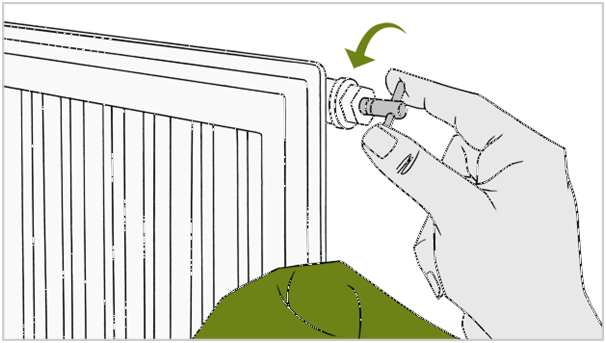If your radiator/s feel cold at the top and warm at the bottom it is likely that the problem is being caused by air that has been trapped in your radiator so you should be able to fix the problem by bleeding your radiator.
Bleeding a radiator is a fairly simple, safe and quick process, it just requires you to open a small valve at the top corner of your radiator with the correct key to allow any trapped air to escape and then closing it again.
Just follow our simple instructions below:
1. Turn off central heating
Before you bleed your radiator, it is very important that you turn off your central heating at the main controls. This will prevent more air from entering the system.
2. Find the bleed valve
The bleed valve is usually located on the top corner of one side of the radiator.
3. Protect the area
Place a cloth or a small bowl underneath the bleed valve to catch any dirty leaking water. Also, wrap your hand in a cloth to shield your hand as any water that escapes from the radiator may be very hot.
4. Find the bleed key
Find a bleed key (or radiator key). If you can’t find the bleed key you should be able to buy a replacement at your local DIY store.
5. Bleed the radiator
First you will need to locate the bleed valve. This will be located at the top of one side of your radiator. To bleed your radiator, insert the bleed key into this valve and carefully turn it ( usually) anticlockwise (a quarter or half turn will should be sufficient ).
The air trapped in your radiator will start escaping with a hissing sound. When water begins to dribble out of the valve you will know that all the air has been removed from the radiator.

6. Re-tighten the bleed valve
Once water dribbles out of the valve you should tighten the valve back to it’s original position. Use the cloth to clean up any spills (be careful, though, as the water can be scalding hot and very dirty).
7. Turn the heating back on
Don’t forget to switch the central heating back on once you’ve finished bleeding the radiator. Check your radiator after an hour to ensure that the radiator is as warm at the top of the radiator as it is at the bottom and that there is no more water leaking from the bleed valve.
Remember, if you are ever in doubt of your ability we advise you to call in an engineer to fix the problem for you.


